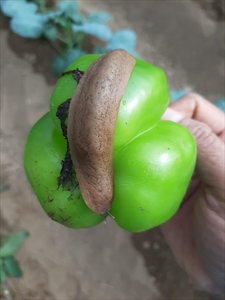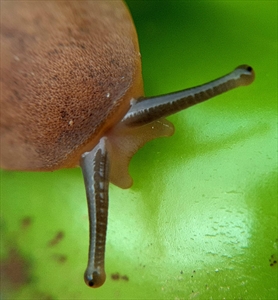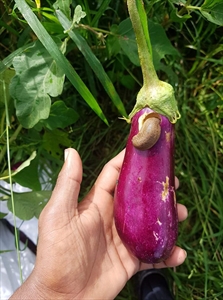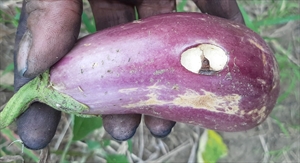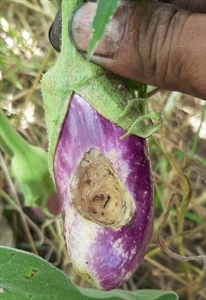Caribbean leatherleaf slug; also known as the bean slug or the American brown slug.
Pacific Pests, Pathogens, Weeds & Pesticides - Online edition
Pacific Pests, Pathogens, Weeds & Pesticides
Caribbean leatherleaf slug (407)
Sarasinula plebeia
Africa (restricted), Asia (restricted), Southeast Asia (Malaysia, the Philippines), North, South and Central America, the Caribbean, Oceania. It is recorded from Australia, Fiji, Guam, New Caledonia, Northern Mariana Islands, and Vanuatu.
Bean (leaves, pods and flowers), and foliage of cabbage, coffee, Cucurbita species, papaya, sweet potato, tomato, and weeds. It is a pest of many nursery plants, including forest species.
An important pest of vegetables. Greyish-brown, flattish with black markings, up to 70 mm long when moving, without a line down the back (Photos 1&2). There are two pairs of tentacles; the upper pair have eyes at the ends (Photo 3). Each slug has both male and female sex organs and can fertilise itself. Up to 30 eggs are laid at one time; they hatch in 20-24 days and the young become adults in about 2.5 months. The slug survives in dry times by burrowing up to 100 cm deep in the soil. It is nocturnal.
In Fiji, eggplants are commonly attacked by Sarasinula plebeia, which eats large amount of the flesh as the fruits mature (Photos 4-8).
Usually found under moist leaves, rotting logs, stones, or on low trees in a variety of places: plantations, grasslands, gardens or forests that have been altered by logging, fire, cultivation. Population increases occur rapidly during long periods of rain.
An invasive species, considered a serious pest of agriculture in South America, and important to ecosystems, human health and trade. It can transmit the rat lung worm, Angiostrongylus cantonensis, which causes meningitis in humans. In the US, Sarasinula plebeia is among the top 10 slug and snail pests.
Look for a flat, greyish-brown slug, up to 70 cm long. Look to see the absence of a stripe running longitudinally along the back. It is similar to the Florida leatherleaf slug (Veronicella species), but this has a pale line down the back. In Fiji, there are two other slugs in the same family: Semperula wallacei and Laevicaulis alte. The first is smaller and paler with a pale stripe running down the back, and the second is larger and darker, also with a stripe on the back.
BIOSECURITY
The fact that the Sarasinula plebeia occurs on vegetables - cabbages, capsicum, coffee, cucurbits, eggplant, and others - means that it is a biosecurity risk for those countries not yet infested with the slug, and every effort should be made to prevent its further spread. It is a threat to crops, to human health, and as a potential competitor to native land slugs (and snails).
NATURAL ENEMIES
Predatory snails, such as Euglandina rosea and Gonaxis quadrilateralis, and flatworms, e.g., Platydemus manokwari, have been introduced into Pacific island countries to control invasive snails (and slugs) such as the Giant African snail, but the effects have been a disaster for local slug (and snail) populations. Such introductions are to be discouraged. Environmental impact studies are essential before the introduction of these predators because of their non-specific nature.
Indian runner ducks will eat slugs (and snails); they are the only type of livestock that will do so. It may be a useful way of managing the slug on vegetables, but less effective where the slug colonises low-growing trees, coffee, papaya and disturbed forests.
CULTURAL CONTROL
Cultural control is important. The following should be done:
- Make a strip of bare earth about 1.5 m wide around cultivated areas. Bands of sand or broken and crushed eggshells are also effective.
- Collect the slug regularly; many factors determine the success of this method, not least the size of the area to be treated and labour availability.
- Set up 'beer traps'. Pour beer into a shallow pan. The beer attracts the slugs, and they fall in and drown.
CHEMICAL CONTROL
The usefulness of metaldehyde (pellets containing 1.5-1.8 % active ingredient) over large areas is not encouraged, it is a chemical toxic to livestock, pets and humans, as well as slugs (and snails). If used:
- Take care to prevent livestock, pets and children from eating the pellets.
- Poisoned snails should never be fed to pigs or other livestock.
- Put the pellets in tins or bamboos in the evening and collect them in the morning. Alternatively, scatter the baits sparsely in and around the plants to be protected so that pets and wildlife will not eat too much if the bait is found. It is best to water the site before applying the baits to stimulate slug activity and increase the chance that the baits will be eaten.
- Note, chemical control needs to be combined with cultural methods to be effective.
More recently, baits with iron-based poisons, e.g., iron phosphate and sodium ferric EDTA have been shown to be effective and safer to use. However, use according to manufacturers' instructions.
Note, a ban on the outdoor use of metaldehyde will be introduced in the UK from March 2022. It can be used in permanent greenhouses. Metaldehyde poses an unacceptable risk to birds and mammals.
AUTHOR Grahame Jackson & Manu Mua
Information from Sarasinula plebeia. Wikipedia. (https://en.wikipedia.org/wiki/Sarasinula_plebeia); and Veronicellidae: Sarasinula spp. Terrestial Mollusc Tool. USDA, UF, Lucid. (http://idtools.org/id/mollusc/factsheet.php?name=Veronicellidae:%20Sarasinula%20spp.); and from Brodie G, Barker GM (2012) Sarasinula plebeia (Fischer, 1868). Family Veronicellidae. USP Introduced Land Snails of the Fiji Islands. Fact Sheet Series, No. 4. (https://www.researchgate.net/publication/265646912_Sarasinula_plebeia_Fischer_1868_Family_Veronicellidae).
Produced with support from the Australian Centre for International Agricultural Research under project HORT/2016/185: Responding to emerging pest and disease threats to horticulture in the Pacific islands, implemented by the University of Queensland and the Secretariat of the Pacific Community.
